Technical Area | Articles
The place to solve all your BIM doubts
[Part 2] What is your BIM implementation strategy?
The Implementation Matrix
BIM Implementation Planning & Budgeting Infrastructures Operation
In my previous post: what is your bim implementation strategy? I had demonstrated why good preparation is an absolute must for a smooth transition from 2D to BIM. And had argued that the one common thing all successful organizations share with each other is a clearly defined road-map to BIM implementation. All successful organization tackle BIM well prepared and know exactly how to do? where to do? and what to do? while on their way to implementing BIM.
Further, I had broken the HOW into three important sections:
- Vision: what are the goals that I wish to achieve through BIM implementation?
- Plan of action: what plan of action should I follow to achieve those goals in the easiest possible way?
- Operational strategy: how do I execute my plan of action?
And had identified the WHERE in 4 different departments in an organization:
- Business operations.
- Internal processes.
- Technical staff, and
- Technology.
Thereafter, I had proposed that the ‘what to do’ or ‘how to implement BIM’ as a complex matrix of the ‘how’ – goals, action plan and operational strategy to the ‘where’ – business operations, internal processes, technical staff and technology of your organization.
In this post, I will demystify the ‘what to do’ using an implementation matrix, and using the implementation matrix will indicate the correct way to relate the how to the where, so that you too can implement BIM in the correct and least disruptive way.
The BIM implementation matrix.

The above table shows the interrelationship of the ‘how’ to the ‘where’ and discusses ‘what’ action could be taken against each of the above parameters for successful BIM implementation. For example, in the ‘business operations’ department of your organization (the where), a new vision could be defined (the what) at the visionary/strategy level (the how). While, at the planning level, a guiding map could be developed to guide business operations. And finally at the operational level, a procedure manual could be written to be followed as a rule book.
Reads complex? In the tables below, I have tried to further simplify the above matrix by taking just one part of the ‘where’ to examine its relationship with the ‘how’ to formulate an action (‘what’) for one department at a time.
1. Business operations.

2. Internal processes.

3. Technical Staff.

4. Technology.

Debunking the common myth – BIM implementation is really just technology implementation?
It’s a common fallacy that BIM implementation is really just about software implementation. In other words, the first three crucial steps I highlighted above are futile, and as such their effective implementation does not affect successful BIM implementation otherwise.
Is that really true? And if it is, what does such a bottom up approach really mean?

Consider the above diagram which portrays a bottom up approach. Wherein technology implementation comes before staff training, internal process amendment and BIM vision, suggesting that an organization’s main purpose for shifting to BIM is just for the sheer delight of employing a new software/hardware. And it is not a cause of concern if such a move means being insensitive to one’s technical staff’s strengths and weaknesses. Or causing disharmony to the company’s internal processes, or completely redefining the company’s BIM vision to suit the needs of the selected technology.
Such an approach though absolutely valid, runs the highest risk of failure. Because as shown previously, an organization shortlists a technology to best suit its business vision, process guidelines and staff training, and not the other way around. This also means that every step in BIM implementation is guided by the previous step. And as such, missing/jumping a step does not guarantee that an organization will reach its destination faster, but that it will reach the wrong destination.
The correct approach, therefore, as seen in hundreds of case studies, is always a top down approach, which requires that you choose the correct technology on the basis of your business vision, internal processes and technical staff.

If you like what you read, I would request you to give back to all infrastructure industry people:
- Share this article on social media
- Leave a comment below, and tell me what you think about this.
- Join the Infra Pioneer Group so we can together take this further.











